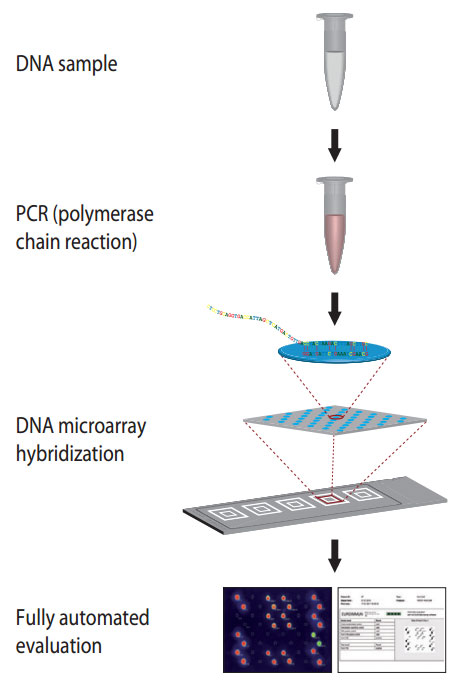EURO ARRAY
What is a microarray and how does it work?
Principle of a DNA microarray
DNA microarrays consist of DNA sequences (probes) which are applied to a solid carrier material, such as glass, in microscopically small spots located at defined positions. The probes differ from one another by their DNA sequence – the order of their building blocks (nucleotides with the bases adenine, A; cytosine, C; guanine, G; thymine, T). When the DNA of a patient contains segments that match the microarray probes, the complementary DNA regions bind together – they hybridize. This binding is measured via a computer-generated reading and evaluated as a positive signal.
Sample preparation: DNA isolation 
In order to investigate with a microarray whether a patient’s DNA contains particular sequences, the DNA must first be extracted from the patient‘s blood. This is performed using DNA isolation kits.
Amplification of patient DNA: Polymerase Chain Reaction (PCR)
The sections of DNA to be investigated are amplified million-fold using polymerase chain reaction (PCR). Two starter DNA molecules (primers) define the region to be copied. If the patient DNA contains the corresponding section (target sequence), the primers bind and the target sequence is copied. This reaction is repeated many times, so that the DNA region between the primers is greatly (exponentially) amplified. The resulting PCR products are labelled with a fluorescent dye, which enables them to be detected subsequently by the microarray. If the target sequence is not present in the patient sample, then the primers cannot bind and the DNA is not amplified.
Analysis of PCR products on the microarray: DNA microarray hybridization
The PCR products are incubated with the microarray. They are first mixed with a hybridization buffer, which provides optimal conditions for binding of the PCR products to the complementary probes on the microarray. This binding is measured via the fluorescence signals emitted by the spots.


